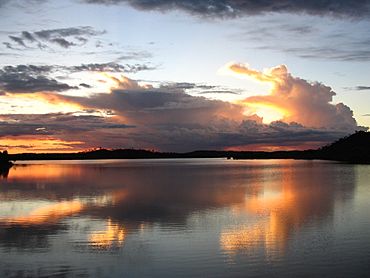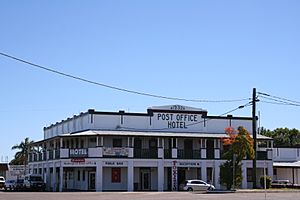Cloncurry, Queensland facts for kids
Quick facts for kids CloncurryQueensland |
|||||||||||||||
|---|---|---|---|---|---|---|---|---|---|---|---|---|---|---|---|

Sunset at Chinaman Creek Dam, Cloncurry
|
|||||||||||||||
| Population | 3,167 (2021 census) | ||||||||||||||
| • Density | 0.39078/km2 (1.0121/sq mi) | ||||||||||||||
| Postcode(s) | 4824 | ||||||||||||||
| Elevation | 186 m (610 ft) | ||||||||||||||
| Area | 8,104.4 km2 (3,129.1 sq mi) | ||||||||||||||
| Time zone | AEST (UTC+10:00) | ||||||||||||||
| Location |
|
||||||||||||||
| LGA(s) | Shire of Cloncurry | ||||||||||||||
| County | Beaconsfield | ||||||||||||||
| State electorate(s) | Traeger | ||||||||||||||
| Federal Division(s) | Kennedy | ||||||||||||||
|
|||||||||||||||
|
|||||||||||||||
Cloncurry is a town in Queensland, Australia. It's often called The Curry by local people. Cloncurry is the main town for the Shire of Cloncurry area.
Cloncurry is known as the Friendly Heart of the Great North West. It celebrated its 150th birthday in 2017. The town has won the Queensland's Friendliest Town award twice. It won in 2013 and again in 2018.
In 2021, about 3,167 people lived in Cloncurry.
Contents
Exploring Cloncurry's Location
Cloncurry is in the north-west of Queensland. It is about 770 kilometres (478 miles) west of Townsville. The town is right next to the Cloncurry River.
Major highways meet here, like the Flinders Highway and the Barkly Highway. The Landsborough Highway also comes into town.
Cattle farming is a very important business in this area. Cloncurry has large yards where cattle are bought and sold. The town also sits on one of the richest mining areas in the world. Copper and gold have been mined here since 1867.
You can still see the effects of open-cut mining on the land. The old Mary Kathleen mine site nearby is now a place tourists like to visit.
Cloncurry's Past: A Look Back
The traditional owners of the Cloncurry area are the Mitakoodi people. They are known as the River people. In 2024, the Mitakoodi and Mayi people officially gained native title rights to their land.
The first Europeans to explore this area were Burke and Wills. They named the Cloncurry River after Lady Elizabeth Cloncurry, who was Burke's cousin. The town later took its name from the river.
In 1867, Ernest Henry found copper in the area. This led to the town growing to support the Great Australia Mine. Gold was also found nearby.
Cloncurry was officially surveyed in 1876 and became a town in 1884.
The Cloncurry Provisional School opened in 1884. It became Cloncurry State School in 1894. St Joseph's School, a Catholic school, opened in 1909.
A local newspaper, The Cloncurry Advocate, was printed in Cloncurry from 1889 to 1953.
The Northern Line railway reached Cloncurry in 1907, making travel and trade easier.
In 1914, a big fire destroyed many buildings in the town. This included the Post Office, a hotel, and several shops. One person died, and the damage cost a lot of money.
The Australian Inland Mission (part of the Presbyterian Church) started a service in 1915. It provided religious help to people in remote areas. Later, the Uniting Church in Australia continued this service, using an aircraft to reach distant places. This service is now called the McKay Patrol.
During World War II, Cloncurry had a special fuel depot for aircraft. This helped supply planes for the RAAF and the US Army Air Forces.
The discovery of uranium at Mary Kathleen in the 1950s brought more wealth to Cloncurry. Until the 1960s, Cloncurry was the main administrative centre for the whole region.
Cloncurry is famous as the starting point for the first-ever flight of the Royal Flying Doctor Service of Australia. This flight happened on May 15, 1928. Today, there is a Royal Flying Doctor Service museum in town.
In 2021, Cloncurry was chosen as the filming location for the TV show Australian Survivor. This was because of travel rules during the COVID-19 pandemic.
People of Cloncurry
The number of people living in Cloncurry has changed over the years.
- In 1996, there were 3,898 people.
- In 2016, the population was 2,719 people.
- In 2021, the population grew to 3,167 people.
Historic Places in Cloncurry
Cloncurry has several sites that are listed for their historical importance:
- Mount Elliott Company Metallurgical Plant and Mill, via Sheaffe Street
- Cloncurry Courthouse, 42–48 Daintree Street
- Cloncurry Post Office, 47 Scarr Street
Learning in Cloncurry
Cloncurry has two main schools:
- Cloncurry State School is a government school for students from Prep (kindergarten) to Year 12. It is located on Daintree Street. In 2018, it had 277 students.
- St Joseph's Catholic School is a Catholic school for students from Prep to Year 9. It is located on Sheaffe Street. In 2018, it had 156 students.
What to Do in Cloncurry
Cloncurry offers many facilities for its residents and visitors:
- There is a public library, an art gallery, and a public swimming pool.
- The town also has a showground and a racecourse.
- The Cloncurry Shire Council runs the public library on Scarr Street.
- The Cloncurry branch of the Queensland Country Women's Association (QCWA) has its rooms at Charlotte Scott House.
- The Cloncurry Uniting Church on Meldrum Street operates the McKay Patrol. This service uses a small plane to provide help to people in very remote areas of Queensland and the Northern Territory. They also hold church services in nearby towns.
Cloncurry's Climate
Cloncurry has a hot, semi-arid climate. This means it has two main seasons:
- A very hot and humid wet season from December to March.
- A warm to hot, mostly dry dry season from April to November.
The average yearly rainfall is about 507 millimetres (20 inches). Most of this rain falls during the wet season.
Cloncurry was once thought to hold the record for Australia's highest temperature. However, later studies showed that the measurement was not taken in standard conditions. The highest temperature recorded at the current weather station is 46.9°C (116.4°F).
| Climate data for Cloncurry (20º40'12"S, 140º30'36"E, 186 m AMSL) (1978-2024 normals, extremes 1939-2024) | |||||||||||||
|---|---|---|---|---|---|---|---|---|---|---|---|---|---|
| Month | Jan | Feb | Mar | Apr | May | Jun | Jul | Aug | Sep | Oct | Nov | Dec | Year |
| Record high °C (°F) | 46.3 (115.3) |
44.9 (112.8) |
43.3 (109.9) |
39.9 (103.8) |
38.7 (101.7) |
34.9 (94.8) |
35.7 (96.3) |
37.7 (99.9) |
41.3 (106.3) |
43.5 (110.3) |
45.2 (113.4) |
46.9 (116.4) |
46.9 (116.4) |
| Mean daily maximum °C (°F) | 37.2 (99.0) |
36.3 (97.3) |
35.8 (96.4) |
33.7 (92.7) |
29.3 (84.7) |
26.3 (79.3) |
26.3 (79.3) |
28.8 (83.8) |
33.1 (91.6) |
36.5 (97.7) |
37.9 (100.2) |
38.8 (101.8) |
33.3 (92.0) |
| Mean daily minimum °C (°F) | 25.2 (77.4) |
24.3 (75.7) |
23.0 (73.4) |
20.1 (68.2) |
15.6 (60.1) |
11.8 (53.2) |
10.8 (51.4) |
12.3 (54.1) |
16.6 (61.9) |
20.6 (69.1) |
23.3 (73.9) |
25.0 (77.0) |
19.1 (66.3) |
| Record low °C (°F) | 16.3 (61.3) |
13.4 (56.1) |
10.0 (50.0) |
7.4 (45.3) |
4.6 (40.3) |
1.7 (35.1) |
1.8 (35.2) |
3.3 (37.9) |
4.2 (39.6) |
8.9 (48.0) |
11.4 (52.5) |
13.8 (56.8) |
1.7 (35.1) |
| Average precipitation mm (inches) | 156.3 (6.15) |
107.5 (4.23) |
78.1 (3.07) |
15.1 (0.59) |
7.1 (0.28) |
7.4 (0.29) |
6.5 (0.26) |
3.9 (0.15) |
6.7 (0.26) |
18.4 (0.72) |
35.9 (1.41) |
72.9 (2.87) |
506.9 (19.96) |
| Average precipitation days (≥ 1.0 mm) | 8.5 | 6.4 | 4.0 | 1.4 | 0.8 | 0.7 | 0.6 | 0.4 | 1.2 | 1.9 | 3.7 | 5.3 | 34.9 |
| Average afternoon relative humidity (%) | 39 | 40 | 30 | 27 | 25 | 27 | 24 | 20 | 19 | 16 | 22 | 27 | 26 |
| Average dew point °C (°F) | 16.9 (62.4) |
17.3 (63.1) |
13.2 (55.8) |
9.6 (49.3) |
5.5 (41.9) |
4.1 (39.4) |
2.1 (35.8) |
1.8 (35.2) |
3.5 (38.3) |
3.2 (37.8) |
8.5 (47.3) |
12.3 (54.1) |
8.2 (46.7) |
| Source: Bureau of Meteorology (1978-2024 normals, extremes 1939-2024) | |||||||||||||
Getting Around Cloncurry
Cloncurry is connected to other towns by bus services like Greyhound. Cloncurry Coaches also runs services to Mount Isa and local trips.
- See Cloncurry Airport
| Preceding station | Queensland Rail | Following station | ||
|---|---|---|---|---|
| Long distance rail services | ||||
| Julia Creek
towards Townsville
|
The Inlander | Duchess
towards Mount Isa
|
||
Famous People from Cloncurry
Several well-known people have connections to Cloncurry:
- Writer Alexis Wright grew up here.
- Footballer Kasey Wehrman was born in Cloncurry in 1977.
- Politician Bob Katter was born here in 1945.
- Athlete Robert Crowther was born in Cloncurry in 1987.
Images for kids




